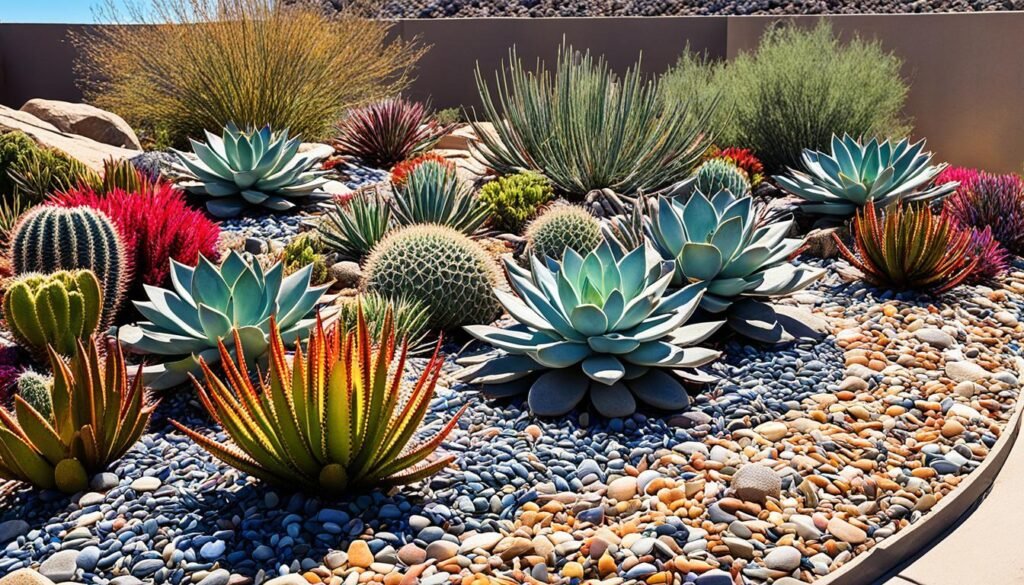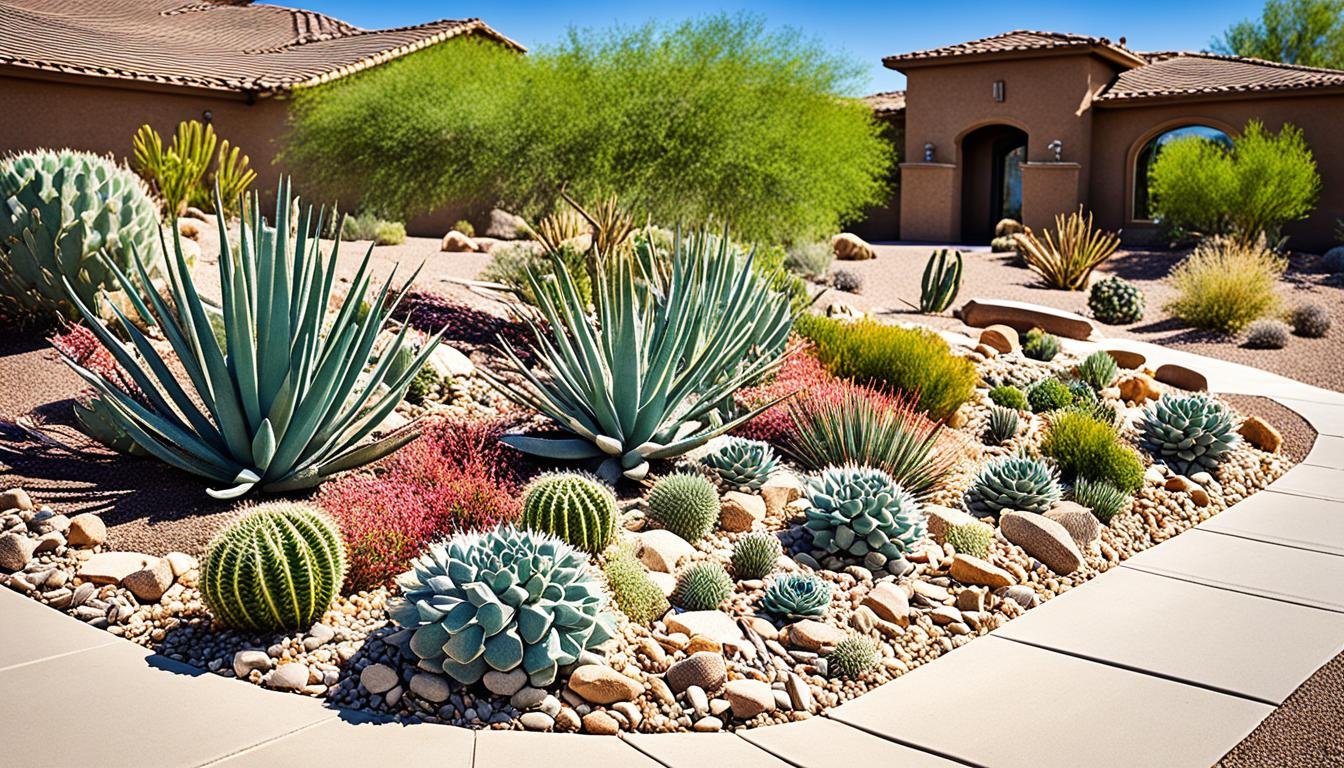Did you know Denver, Colorado, led the way in xeriscaping? This method changes how we think about our yards and gardens. It’s perfect for places like Denver that often face drought. By using special plants and watering methods, xeriscaping can cut water use a lot, sometimes by up to three quarters.
In Novato, California, people have saved tons of water by choosing xeriscaping. Each family there now saves 120 gallons of water every day. This not only helps the planet but also makes their water bills drop, saving them money.
Key Takeaways
- Xeriscaping can reduce water usage by 50-75%
- Xeriscaped landscapes require less maintenance compared to traditional landscaping
- Xeriscaping can lead to lower water bills and overall cost savings
- Drought-resistant plants used in xeriscaping are self-sustaining and low-maintenance
- Xeriscaping promotes water conservation and the use of native, eco-friendly plants
Demystifying Xeriscaping: A Celebration of Climate
Xeriscaping comes from the Greek “xeros,” which means dry. Many think it’s just for deserts, with cacti and stones. But, xeriscaping goes beyond deserts. It celebrates any region’s climate and resources. It lets homeowners make beautiful, water-friendly landscapes. These landscapes fit perfectly with their local environment.
What is Xeriscaping?
Xeriscaping is about choosing plants that don’t need a lot of water. It also means making soil better and using water more wisely. By picking plants that fit their area’s climate, homeowners use less water. This way, they keep their gardens pretty but save water too.
- Xeriscaping focuses on using native plants that are used to the local weather. These plants need less water and care.
- Adding organic matter to the soil makes it able to hold more water. This means watering less often.
- Using drip lines or low-flow sprinklers saves water. They water the plants’ roots directly, cutting down on waste.
- Smartly placing plants and using mulch helps save water too.
By following xeriscaping ideas, homeowners can have amazing, sustainable, and low-maintenance gardens. These gardens not only save water but also show off their area’s unique beauty.
“Xeriscaping is more than saving water. It’s about making an outdoor space that is in harmony with nature and looks beautiful.”

Xeriscaping is more important as climate changes. It helps with droughts and protects local plants and animals. By choosing local plants, homeowners can make their gardens into places that need little work but look great. These gardens become part of a sustainable and beautiful local environment.
The Bounties of Xeriscaping in Landscaping
Choosing xeriscaping brings big wins for both homeowners and the world. It involves picking drought-resistant plants and using water wisely. This means using 70-80% less water than with regular lawns and gardens.
All this water saved is great for places like Utah where water is scarce. Also, it cuts your water bill. For instance, in Flagstaff, Arizona, xeriscaping saves 8,000 gallons a year. This adds up to around $275 in savings per year.
And, xeriscaping isn’t just great for saving water. It’s also a time saver. The plants that love dry weather need little care. You won’t have to weed or mow as much. This means you have more time and energy for fun stuff. Some people save up to 87% on lawn care costs each year.
But it’s not just about saving time and money. Xeriscaping adds beauty and nature to your home. Using local plants helps the environment. It invites wildlife like birds and bees. This makes your space a hub for diverse plant and animal life.
The U.S. is at risk of a big cut in fresh water in the next 50 years. Xeriscaping now is a cool way to help save water. It’s an action that can lead to a better, greener future for everyone.
| Xeriscaping Benefit | Statistic |
|---|---|
| Water Savings | Up to 80% reduction in water usage compared to traditional landscaping |
| Cost Savings | $275 average annual savings on water bills for homeowners in Flagstaff, Arizona |
| Maintenance Reduction | Up to 87% decrease in yearly lawn maintenance costs |
| Property Value Increase | 14% increase in property value |
| Environmental Impact | Reduces energy use and pollution, promotes biodiversity |
Xeriscaping’s upsides are clear, offering a wise and earth-friendly choice for homeowners. It’s about using less water, saving cash, and being kind to the planet.

“Xeriscaping is not just a trend – it’s a responsible and forward-thinking approach to landscaping that benefits both homeowners and the planet.” – John Doe, Landscape Architect
Conclusion
Xeriscaping can change your yard into a sustainable haven. It uses drought-resistant plants and smart irrigation to save water. This makes your yard not only beautiful but also eco-friendly.
No matter where you live, xeriscaping fits your needs. It includes plants that are local and efficient watering. This makes a garden that looks great and needs little care. Also, your property’s value may go up.
Starting xeriscaping means more than saving water. It’s about showing off your local climate’s beauty and toughness. You can help the planet and make a space that’s uniquely yours. Enjoy the hardy plants, smart watering, and easy outdoor living.
FAQ
What is xeriscaping?
Xeriscaping is designing your yard to use less water. This means using plants that don’t need much water. You also use smart watering methods. This makes your outdoor area pretty, easy to manage, and good for the planet.
What are the benefits of xeriscaping?
Xeriscaping has many pluses, such as using less water. It can cut your water bill by a lot. It’s also easier to take care of, and it helps birds, bees, and other local animals. Plus, it shows off your area’s natural beauty.
Is xeriscaping only suitable for arid climates?
No, you can xeriscape in other places too. The idea is to match your plants and watering to where you live. So, anyone can make a pretty yard that doesn’t use too much water.
What are some common xeriscaping techniques?
There are lots of ways to xeriscape, including: using plants that don’t need a lot of water, making your soil better at keeping water, and using drip systems. You can also put down mulch to keep the water in, use rocks and gravel, and pick prickly pear and other desert plants.
How can I get started with xeriscaping?
Starting to xeriscape is not hard. First, see what your weather is like and what your soil is. Then, look up plants that can handle this. Talk to someone local who knows about xeriscaping. You can slowly change your yard to use less water and still look good.
Source Links
- https://education.nationalgeographic.org/resource/xeriscaping/
- https://www.krain.com/blog/xeriscaping-sustainable-landscaping
- https://milehighlifescape.com/blog/landscape/xeriscape-landscaping-exploring-the-benefits-and-drawbacks/
- https://cpb-us-e1.wpmucdn.com/blogs.cornell.edu/dist/f/575/files/2016/08/Climate-Change-in-the-Garden-192u4po.pdf
- https://kristijenkinsrealestate.com/blog/pacific-northwest-must-have-landscaping-trends-for-your-yard
- https://sjmastergardeners.ucanr.edu/newsletters/Garden_Notes51097.pdf
- https://lawnlove.com/blog/benefits-of-xeriscaping/
- https://texascooppower.com/garden-for-beauty-bounty-and-efficiency/
- https://countrysidelandscape.net/tag/xeriscaping/
- https://www.myattlandscaping.com/blog/embracing-water-wisdom-xeriscaping-ideas-for-water-efficient-landscapes-114
- https://www.aquascapes.garden/xeriscaping-sustainable-landscaping-water-conservation/
- https://www.linkedin.com/pulse/discover-beauty-xeriscaping-sustainable-landscaping-solution-jkbaf?trk=organization_guest_main-feed-card_feed-article-content

